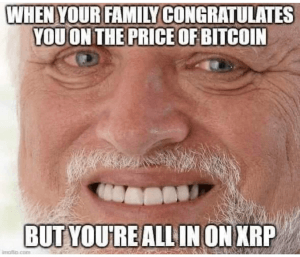While Ripple Labs is in the trenches battling an ongoing SEC lawsuit, much of the XRP Army is set to be airdropped two different tokens via the Flare network – Spark, and the newly announced Songbird.
Flare, Spark, army, battle… it all sounds dramatic (Songbird kinda ruins it) and a lot to unpack. It is a bit, but let’s break it down as simply as we can.
What’s XRP?
XRP is a cryptocurrency built to speed up payments between financial institutions. It was created by Ripple Labs, receiving a $US55 million funding round in late 2016, attracting huge hype and a loyal, almost cult-like fan base of HODLers that has come to be known as the XRP Army.
It helped kickstart the bullrun of 2017 and became the best-performing crypto asset that year, with a stupendous 36,018% gain over 12 months.
It’s since down 83.6% from those heady days of moons and Lambos, although to be fair, many other cryptos are currently a very long way off all-time highs as well.

It’s different from Bitcoin (Proof of Work) and Ethereum (soon to be fully Proof of Stake) in that it can’t be mined and relies on a consensus protocol to validate account balances and transactions.
It’s also a crypto that generates a lot of hate in the decentralisation-loving cryptoverse for its aims of engaging and increasing the efficiency of traditional centralised banking, and for its perceived centralised nature itself.
Ripple Labs owns a huge amount of XRP and the argument is that the company has too much influence on the value of the token.
The SEC (the US Securities and Exchange Commission) has its own beef with Ripple Labs and XRP. More on that further below…
What’s Flare?

Flare is a blockchain protocol that is going to bring full smart contract and decentralised finance utility to the XRP ecosystem.
Thanks to the sharing-is-caring nature of open-source technology, it’s built on the back of Ethereum’s Virtual Machine (EVM) that enables the creation of decentralised applications. This means that Ethereum applications will be able to be deployed on the Flare Network.
One of Flare’s main goal’s is network interoperability – the idea of a system that can become a fully compatible crypto melting pot of cross-chain activity. Many other blockchains, including Ethereum, Polkadot, Cosmos and Cardano are building out interoperability functionality as well.
Flare is also being used to airdrop various additional crypto assets to XRP holders.
What’s Spark?
Spark (FLR) is the Flare’s native utility token and will be used to collateralise F-assets and provide liquidity for the Flare smart contract network.
F-assets are wrapped tokens. You can think of them as representations of digital assets that live on other networks, but “wrapped” to function within the Flare network.
The specific F-assets upon the launch of Flare will be XRP, Litecoin and Elon Musk fave, Dogecoin.
You can read more about how Flare and Spark will operate here.
When Spark airdrop?
The Spark airdrop should be happening “soon” – tokens could be arriving in XRP holder’s designated wallets before the end of July, according to Flare Networks original schedule. Although, it could also depend on when the Flare network itself is actually launched.
This could still be a couple of months away, so the XRP Army might need to remain patient a while longer yet.
If you’re not an XRP holder but think this sounds like an idea for a quick flip, there’s no point rushing out to buy XRP for the purpose of getting this airdrop.
A “snapshot” of XRP addresses on official, affiliated exchanges and wallets, was taken on December 12. You had to be holding at that time to receive the upcoming tokens on a 1:1 basis according to how many XRP you had on that date.
The first drop will represent 15% of the 45 billion Spark tokens being gifted to XRP holders. There will be a total supply of 100 billion Spark, and the rest of the airdrop distribution will be drip-fed over the course of two to three years.
Avoiding airdropping it all at once should protect the price of Spark from dumping too heavily, if at all, once the XRP Army get their hands on the tokens.
Songbird to drop, too

The same XRP holders who are receiving Spark, will also be getting a bunch of the newly announced Songbird (SGB) token. The distribution list is based on the same snapshot of wallet addresses that occurred in December.
For every 1 XRP at the time of the snapshot, 0.1511 SGB tokens will be allocated, and the first drop is scheduled to happen within the next six weeks.
Flare Networks announced the airdrop this week ahead of its plans to launch the new token, which will be a “canary network” – a testnet project, much like how Kusama functions for Polkadot. The project is scheduled to go live in September this year.
In a blog post, CEO and founder of Songbird, Hugo Phillon, described Songbird as an “adversarial environment” for live testing and bug discovery over the long term.
The SEC vs Ripple

The legal drama slowly unfolding between the SEC and Ripple Labs stems from the SEC’s belief that XRP is a centrally issued security, and not a commodity, such as gold… or Bitcoin. Or, for the present moment, Ethereum and therefore most other crypto assets.
As Stockhead reported in April, the SEC also alleges the founders, including CEO Brad Garlinghouse, didn’t register XRP properly, before issuing over 14 billion units and generating more than $US1.3 billion in fiat currency.
The result of the case is important to the rest of the industry as it could affect how big a role the US has in determining crypto’s future.
If Ripple loses, SEC attention may turn to Ethereum, potentially stifling cryptocurrency innovation as a whole. However, as most cases (96% apparently, according to US attorney Jeremy Hogan) involving the SEC tend to end in settlement, there is no point losing sleep over this just yet.
The consequences for Ripple Labs, in the meantime, apart from legal fees and time, have included a dramatic decline in token price and bans or suspensions from more than 50 exchanges, including Coinbase and Binance.
Reports suggest the case could resolve in early 2022, although further delays seem likely.
